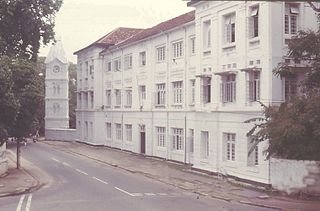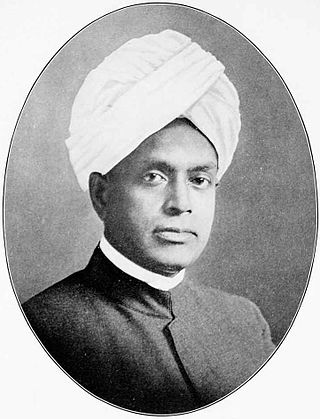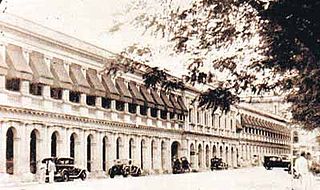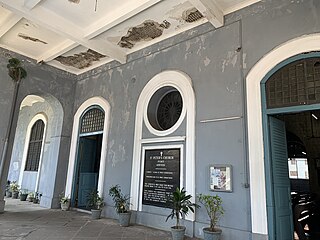Related Research Articles

Ceylon Medical College was a public medical school in Ceylon. The college was established in 1870 as the Colombo Medical School. The college was based in Colombo. The college was merged with Ceylon University College in 1942 to form the University of Ceylon. The medical college became the university's faculty of medicine. The college was also known as Colombo Medical College.

Sir Ponnambalam Ramanathan, was a Ceylon lawyer and politician who served as Solicitor-General of Ceylon.

Sir James Peiris was a prominent leader in the Sri Lankan independence movement, the first elected Vice-President of the Legislative Council of Ceylon and the first native Governor of Ceylon (Acting).

The Legislative Council of Ceylon was the legislative body of Ceylon established in 1833, along with the Executive Council of Ceylon, on the recommendations of the Colebrooke-Cameron Commission. It was the first form of representative government in the island. The 1931 Donoughmore Constitution replaced the Legislative Council with the State Council of Ceylon.

Gunapala Piyasena Malalasekera, OBE, JP, was a Sri Lankan academic, scholar and diplomat best known for his Malalasekara English-Sinhala Dictionary. He was Ceylon's first Ambassador to the Soviet Union, Ceylon's High Commissioner to Canada, the United Kingdom and Ceylon's Permanent Representative to the United Nations in New York. He was the Professor Emeritus in Pali and Dean of the Faculty of Oriental Studies.

Ceylon University College was a public university college in Ceylon. Established in 1921, it was Ceylon's first attempt at university education. The college didn't award degrees under its own name but prepared students to sit the University of London's external examination. The college was based in Colombo. The college was merged with Ceylon Medical College in 1942 to form the University of Ceylon. The college was also known as University College, Ceylon; University College, Colombo; and Colombo University College. Its buildings and grounds are now occupied by the University of Colombo which is considered its successor.
Peter Daniel Anthonisz was a burgher doctor who was the first Ceylonese to obtain an M.R.C.P. and F.R.C.S. He was also the inaugural president of the Ceylon Branch of the British Medical Association and a member of the Legislative Council for nine years.

The Hamilton Canal is a 14.5 km (9.0 mi) canal connecting Puttalam to Colombo, passing through Negombo in Sri Lanka. The canal was constructed by the British in 1802 and completed in 1804. It was designed to drain salt water out of the Muthurajawela wetlands. The canal was named after Gavin Hamilton, the Government Agent of Revenue and Commerce.

Grand Oriental Hotel or GOH is a 3 star heritage hotel, located in Colombo, Sri Lanka.

St. Peter's Church is one of the oldest continuously functioning churches in Colombo, Sri Lanka. It is located on Church Street in Colombo Fort, on the northern side of the Grand Oriental Hotel.

Dewan Bahadur Chevalier Ignatius Xavier Pereira was a colonial-era Ceylonese businessman and politician.
Henry 'Harry' Abdy Fellowes-Gordon was a British tea planter and politician in Colonial Ceylon.
Trams existed in Sri Lanka's capital Colombo from 1899 to 1960.
Colonel Oswald Boyd Forbes was a tea-broker, military officer and politician in Colonial Ceylon.
Maurice Salvador Sreshta served as the Postmaster General of Ceylon from 1923 to 1928.
Francis Jagoe Smith CMG was the Postmaster General of Ceylon and Director of Telegraphs, serving in the position from 1913 to 1923.
Henry Luttrell Moysey ISO was the ninth Postmaster General of Ceylon and Director of Telegraphs, serving from 1900 to 1906.
Thomas Edward Barnes Skinner was the Postmaster General of Ceylon, between 1871 and 1896.
Harry Archibald Burden was a Ceylonese public servant and the thirteenth Postmaster General of Ceylon (1929-1933).

James George Smither FRIBA (1833–1910) was an Irish architect and a Ceylonese public servant.
References
- ↑ "The Pagdens". Epson and Ewell History Explorer. Retrieved 11 November 2020.
- 1 2 Kelly's Handbook to the Titled, Landed & Official Classes. Vol. 44. Kelly's Directories. 1918. p. 1185.
- ↑ Bishop, George, ed. (1873). Register of Wellington College: For the years 1859-1873 July. Wellington College. p. 56.
- ↑ Venn, J. A., ed. (1953). Alumni Cantabrigienses : A biographical list of all known students, graduates and holders of office at the University of Cambridge, from the earliest times to 1900. Vol. V. Cambridge University Press. p. 3.
- ↑ University of Cambridge (1888). Register. Cambridge University Press. p. 551.
- ↑ "Appointments" (PDF). The London Gazette . 14 December 1880. p. 6730. Retrieved 11 November 2020.
- ↑ "Ceylon Light Infantry". International Ceylon Database. Retrieved 11 November 2020.
- ↑ King's College, Cambridge (1929). Withers, John James (ed.). A Register of Admissions to King's College, Cambridge, 1797-1925 (2 ed.). J. Murray. p. 101.
- ↑ Addison, Henry Robert; Oakes, Charles Henry; Lawson, William John; Slade, Douglas Brooke Wheelton Sladen, eds. (1922). Who's Who. Vol. 74. A. & C. Black. p. 2060.
- ↑ Debrett, John, ed. (1931). Debrett's Baronetage, Knightage, and Companionage. Dean & Son Limited. p. 1965.
- ↑ "Debates of the Legislative Council of Ceylon, 1918". Colombo: Colonial Printer. 1919: iii.
{{cite journal}}: Cite journal requires|journal=(help) - ↑ "No. 29938". The London Gazette . 12 February 1917. p. 1459.
- ↑ Colonial Office (1924). The Colonial Office List for 1924. Vol. 63. Harrison. p. 490.
- ↑ The Oriental Club (1925). Wheeler, Stephen (ed.). Annals of the Oriental Club, 1824-1858. London, England: Private Circulation. p. 196.